[Dry goods] Listen to champion Wu Zelin's analysis of "Gold Cup Theory"
For professional baristas, please follow the coffee workshop (Wechat official account cafe_style)
There are more and more coffee friends around, and some of them take coffee very seriously and often put forward some constructive and valuable experiences or experiences, of course, it will extend to a variety of problems to be explained and identified.
Recently, many fans are talking about the Golden Cup Theory (Gold Cup).
A long time ago, the European Fine Coffee Association (SCAE) put forward an argument that "good coffee" should have a standard extraction rate and concentration: the Golden Cup Theory (Gold Cup), which holds that "good coffee" must meet two conditions at the same time:
1. The extraction rate is between 18% and 22%.
two。 The coffee concentration is in the range of 1.2% to 1.45%.
What is the exact content? What are the key points that we need to refer to? What arguments are superfluous to the average consumer?
Today, let's take a look at how the master BERG WU (Wu Zelin, winner of the 2016 World Cup barista contest) concretely analyzes the "golden cup theory":
Many coffee brewers should be familiar with the golden cup theory, but I think many people don't quite understand what the golden cup theory is talking about.
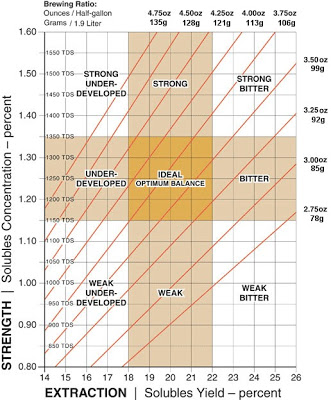
You can refer to the picture above, which is a standard gold cup theory chart (also known as extraction control chart; Brewing Control Chart). Do you feel dazzled and don't know what the point is? It doesn't matter. Let's talk about what this picture is going to say in a simpler way.
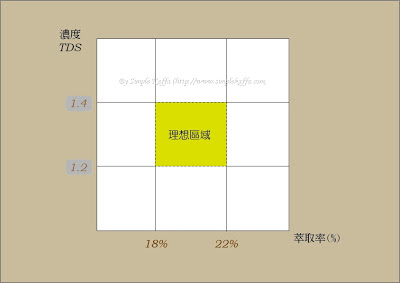
Then let's take a look at the picture above. Let's delete some unnecessary information first. In fact, the conclusion expressed by the golden cup theory is very simple. The vertical axis of the chart is the concentration of coffee, and the horizontal axis is the extraction rate of coffee. When you brew coffee with a concentration of 1.2-1.4 TDS and an extraction rate of 18%-22%, it is considered to be within the ideal extraction range.
So let's explain the nouns mentioned above. Concentration is easy to understand, which is the concentration of "solids" in coffee. What about the extraction rate? The extraction rate refers to the coffee powder you use to brew, and what percentage of the substance is dissolved in the coffee. For example, when you use 100g coffee powder for brewing, after brewing the coffee, remove the moisture from the coffee grounds (whether dried or dried), if there is 80g left, which means that 20g of the substance is dissolved in the coffee, then the extraction rate of this cup of coffee is 20%.
Then the big question is, for the average brewer, would you want to take a lot of trouble to measure these data after making a cup of coffee? At least I would never do that. Of course, there are also companies that have launched instruments and software for measuring TDS and calculating extraction rates, which allow you to measure quickly, but that is not the investment that ordinary brewers need.
It is because the measurement of these data is too difficult for the average brewer, so I think the data provided by the Golden Cup theory is "completely unimportant" to the average person. On the contrary, what matters is something that can't be easily known just by looking at the chart.
If you are a general cook, then the data in the golden cup theory is not important!
Since the data is not important, what is important? I think it is "the effect of extraction rate on taste". When you have a thorough understanding of the relationship between the extraction rate and the taste trend, it will definitely be of great help to your cooking adjustment.
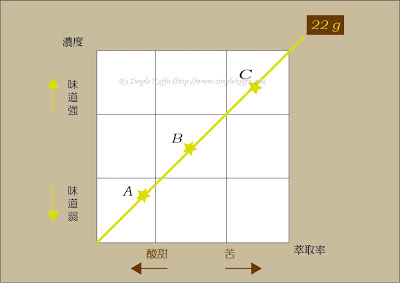
Let's take a look at this picture. I removed all the data from the vertical and horizontal axis, and replaced it with the relationship between "concentration / taste" and "extraction rate / taste". When the coffee concentration is high, you will feel that the overall taste is stronger, and vice versa. The most interesting thing is that when the extraction rate is low, the sweet and sour feeling will be more obvious, while when the extraction rate becomes higher, the bitterness will be more obvious.
The diagonal line in the figure is the relationship between extraction rate and concentration when cooking with a fixed amount of powder. When the extraction rate of coffee increases, so does the concentration of coffee. In other words, compared with the "concentration / taste" and "extraction rate / taste" relationship we replaced, we can come to a very simple conclusion: "with the increase of the extraction rate, the taste of coffee will become stronger and stronger." and the taste will be more obvious from the beginning, slowly become accompanied by bitterness, and even end up with bitterness.
If you have the spirit of experiment, I suggest you try to verify it by cup test. Pick up the coffee beans you have at hand and soak them with the same ratio of powder to hot water (the ratio of powder to water is the same as the ratio of coffee you usually make). Soak the first cup for one minute and then break the dregs, or you can use a filter cup to filter out the coffee grounds. The second cup is soaked for two minutes, and the third cup is three minutes. In this way, you can get the coffee at the three spots A, B and C in the picture, and then try to drink it to see if it is the same as what you just said.
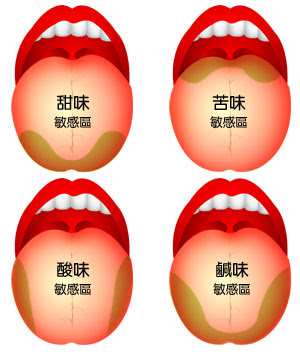
When tasting, there are also some tips! First of all, let's take a look at the distribution of taste buds. During the tasting process, you can recall this picture and focus on two things, the first is the intensity of the sweet and sour, and the second is the location of the sweet and sour. Taste buds that can sense sour taste are mostly distributed on both sides of the tongue and extending to the front of the tongue. Sweet taste buds are distributed in front of the tongue, and the whole tongue is usually regarded as a dense place of sweet taste buds in experience. Bitter taste buds are distributed in the root of the tongue, the right amount of bitterness can bring out a long throat rhyme. Let's not talk about salty taste for the time being, because salty taste is not a very pleasant taste in the field of coffee. In the tasting experiment of golden cup theory, we hope that everyone will focus on the relationship between sweet and sour taste and extraction rate.
After tasting, it should be emphasized here that the so-called extraction rate is low, sour and sweet is more obvious, and the high extraction rate is more bitter, which refers to the ratio between sour, sweet and bitter, rather than absolute strength. For example, the sweet and sour "intensity" of extraction point B is sometimes higher than that of extraction point A, just because extraction point B will be accompanied by bitterness, so when drinking, the proportion of sweet and sour feeling in all the tastes becomes lower, so there will be the illusion that sweet and sour feelings become less obvious.
So here, I would like to emphasize once again the most useful point of the golden cup theory for ordinary brewers. Under the same amount of powder and extraction structure, with the increase of the extraction rate, the taste of coffee will become stronger and stronger, and the taste will be more obvious from the beginning, slowly become bitterness accompanied by bitterness, and even leave only bitter taste in the end.
Then let's talk about the effect of powder on coffee brewing. If you just imagine, I think it is easy for everyone to come to the conclusion that "the more the powder, the stronger the taste, and the less the powder, the weaker the taste." this conclusion is not wrong, but there are other details that we need to pay attention to. Do you remember the content of the last time? In addition to the strength of the taste (that is, the vertical axis of the chart), the most important thing for the average user is the distribution of bitterness and bitterness.
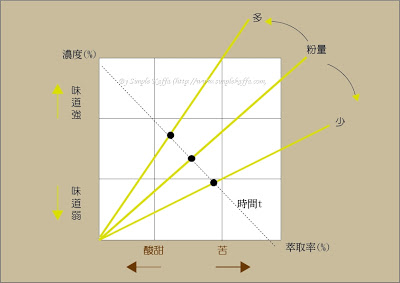
Let's take a look at this picture. There are two new diagonal lines in the picture. The diagonal powder at the top is more than the diagonal powder at the middle, and the diagonal powder at the bottom.
The amount of powder is less than the diagonal powder in the middle. You can see that when three different amounts of powder reach the same extraction rate (the same feeling of bitterness and bitterness), the cup with more powder will have a stronger taste, and vice versa.
This is the end of the explanation, let's do a little exercise. If you think the brewed coffee is very light and has only throat rhyme, how do you adjust it when you want to feel more sour and sweet? Answer: you can imagine that the extraction point is located in the lower right block of the Jiugong grid, then you must increase the amount of powder (move the extraction point up) and lower the extraction rate (let the extraction point move to the left). This will allow the extraction point to fall into your own default ideal extraction range!
Then there is a key point that is not shown in the gold cup theoretical diagram. Take the cup test as an example. Suppose we soak the 150cc coffee with 10g coffee powder for 2 minutes. The distribution of the sweet and sour coffee is very satisfactory, but the taste is a little light, so how to adjust it? As can be seen from the above picture, we must increase the amount of powder and maintain the same extraction rate. But the interesting thing is that if we soak the 150cc coffee for 2 minutes with 12g coffee powder, you will find that the distribution of sweet and sour coffee is not the same as that of the previous cup of coffee, but slightly more sour and sweet. In other words, when we increase the amount of powder, if the other extraction conditions remain the same, then the extraction rate will be reduced, as shown by the dotted line in the figure. On the contrary, when the amount of powder decreases, if the other extraction conditions remain the same, then the extraction rate will increase. In other words, when the amount of powder changes, you must also think about whether other parameters of cooking need to be adjusted! In the case of just now, I may soak 12g powder for two and a half minutes to achieve a similar distribution of sweet and sour!
When you know this, congratulations, you have caught the key point of the golden cup theory, although there are many factors that affect the taste of coffee are not included in this theory. But no matter what kind of cooking equipment, you can try to think with the logic of the golden cup theory. This is also the basis on which baristas in our store are required to be familiar with.
Important Notice :
前街咖啡 FrontStreet Coffee has moved to new addredd:
FrontStreet Coffee Address: 315,Donghua East Road,GuangZhou
Tel:020 38364473
- Prev
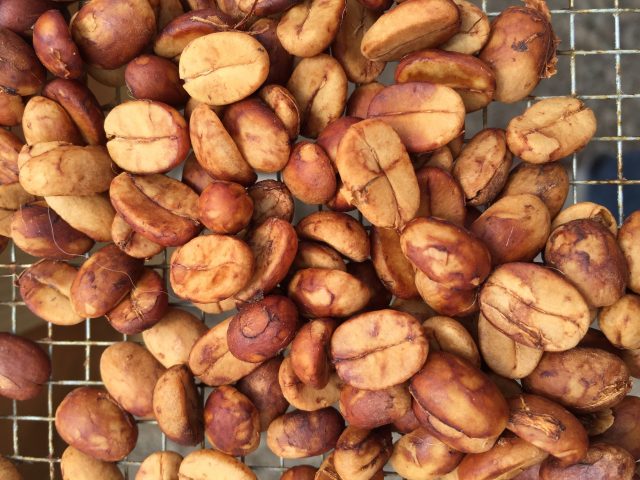
How does the fermentation of raw beans affect the flavor of coffee?
Professional baristas Exchange follow Coffee Workshop (official Wechat account cafe_style) Sasa, winner of the 2015 World Barista Competition, uses an innovative fermentation process called washing carbon dioxide impregnation, two years later he has his own estate and is therefore more committed to fermentation technology. In fact, at the Budapest World Series in June 17, Sasa aimed at controlling fermentation
- Next
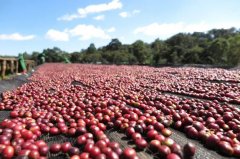
Why do Wang ce's coffee beans have different colors? the uniqueness of low-temperature yeast treatment.
# 227 belongs to the high-end Makers Serier among the many coffee items of 90 +, and this series belongs to the contestant-level items participating in coffee competitions around the world. As long as you are willing to participate in the competition and get the approval of 90 +, you can go to the place of origin and work with the origin processor to complete the coffee product you want. In the report of Uncle Coffee's exclusive interview with Chad Wang, for # 22
Related
- What is the meaning of lactic acid fermentation with coffee bean treatment?
- How to judge the state of foam by sound?
- How does the latte pull out the unicorn pattern? Come to get for a little trick to improve the flower pull!
- Will flower pulling affect the taste of the latte?
- Do you know the history of coffee?
- The difference between honey treatment and sun washing what is raisin honey treatment?
- What kind of milk can a novice use to make coffee foam to keep the foam longer? The correct method and skills of milking tutorial sharing
- Why do washed coffee beans taste sour? Flavor characteristics of washed Coffee
- Introduction to the skill of how to practice the size and height of water injection around the circle of hand-brewed coffee
- How do beginners practice coffee flower drawing from scratch?

